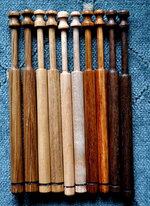monophoto
Member
Last year, wife and I toured a monastic community where one of the residents was involved in lace making. I had never seen that craft before, and was intrigued by the intricate bobbins that she was using to hold the thread used to make lace.
I did some research on the internet to learn more about lace making, and in particular, lace bobbins. Bobbins are a very quick and easy project for the wood turner and can be made from scraps of wood that would otherwise be relegated to the burn box. Whether there is a large market for bobbins is another matter - my sense is that the lace-making world is very small. But lace makers need lots of bobbins - it takes a dozen or more bobbins to make a strip of lace only a couple of inches wide, so serious lace makers will have hundreds in their collection.
Anyway, I was inspired to try to make some bobbins, and here is the result. Each bobbin starts with a blank about 5 - 5.5" long, and about 3/8" square. An important requirement is that because the bobbin is very thin (about 1/8"), the wood must have a straight grain pattern, especially in the bobbin area. Bobbins are used in pairs, so it makes sense to make them as matched pairs. There are several profiles in common use - the bobbins I made are the English Midlands design.
It is important that bobbins be thoroughly sanded and given a very smooth finish so that there are no rough edges that can snag threads. I sanded to 1200 grit, and then used an abrasive wax to polish the wood before applying a shop-made shellac-wax finish.
A naked Midlands bobbin is very light - mine average less than 2.5 grams each - so they are often 'spangled'. A short string holding three to five beads is attached to the handle-end with thread or wire. These beads personalize the bobbins and also help identify the pairs. More importantly, spangles add weight and keep the bobbins from rolling on the bolster or pillow upon which lace is woven. The additional weight helps maintain tension in the thread used to create lace. I put a burned ring about 1/4" in from the end to disguise the hole that I drilled to accommodate the spangle.
The picture illustrates pairs in white oak, ash, maple, canary wood, and walnut.
I did some research on the internet to learn more about lace making, and in particular, lace bobbins. Bobbins are a very quick and easy project for the wood turner and can be made from scraps of wood that would otherwise be relegated to the burn box. Whether there is a large market for bobbins is another matter - my sense is that the lace-making world is very small. But lace makers need lots of bobbins - it takes a dozen or more bobbins to make a strip of lace only a couple of inches wide, so serious lace makers will have hundreds in their collection.
Anyway, I was inspired to try to make some bobbins, and here is the result. Each bobbin starts with a blank about 5 - 5.5" long, and about 3/8" square. An important requirement is that because the bobbin is very thin (about 1/8"), the wood must have a straight grain pattern, especially in the bobbin area. Bobbins are used in pairs, so it makes sense to make them as matched pairs. There are several profiles in common use - the bobbins I made are the English Midlands design.
It is important that bobbins be thoroughly sanded and given a very smooth finish so that there are no rough edges that can snag threads. I sanded to 1200 grit, and then used an abrasive wax to polish the wood before applying a shop-made shellac-wax finish.
A naked Midlands bobbin is very light - mine average less than 2.5 grams each - so they are often 'spangled'. A short string holding three to five beads is attached to the handle-end with thread or wire. These beads personalize the bobbins and also help identify the pairs. More importantly, spangles add weight and keep the bobbins from rolling on the bolster or pillow upon which lace is woven. The additional weight helps maintain tension in the thread used to create lace. I put a burned ring about 1/4" in from the end to disguise the hole that I drilled to accommodate the spangle.
The picture illustrates pairs in white oak, ash, maple, canary wood, and walnut.

